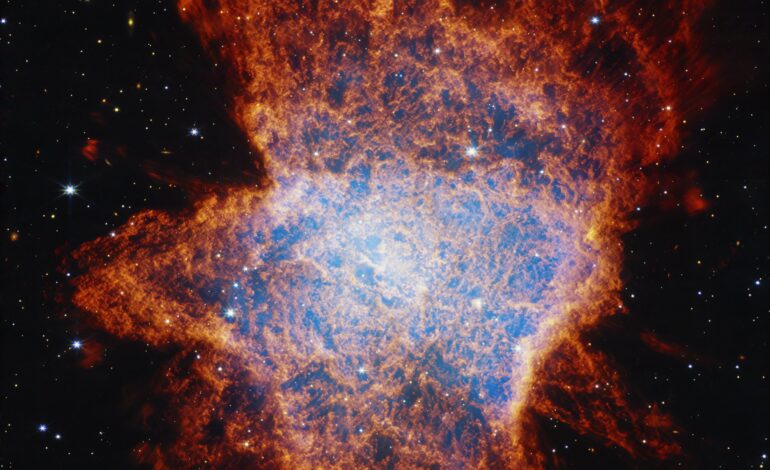JWST Reveals Complex Structures in NGC 6072 Planetary Nebula

The James Webb Space Telescope (JWST) has captured intricate details of the NGC 6072 planetary nebula, located approximately 3,060 light-years away in the southern constellation of Scorpius. This nebula, which deviates from the typical shapes observed in planetary nebulae, provides new insights into stellar evolution. The latest images, taken with Webb’s Near-Infrared Camera (NIRCam) and Mid-Infrared Instrument (MIRI), reveal a complex structure that could reshape our understanding of how stars interact at the end of their lifecycle.
The high-resolution images from NIRCam present a vibrant hot central core surrounded by elliptical outflows, suggesting a multi-polar configuration. These outflows have formed two prominent lobes of gas and dust that intersect the central region at nearly vertical angles. A third lobe extends perpendicularly, establishing an equatorial plane. The central area is marked by dark pockets enveloped in orange material, which becomes increasingly red as it moves farther from the core. This color gradient indicates that the gas and dust cool as they drift away from the intense heat of the core.
The observations hint at a dynamic interplay between at least two stars at the nebula’s center. One of these stars is likely a younger companion to the aging star, which has already expelled a significant amount of material. The detailed imaging from MIRI highlights the longer-wavelength infrared data, accentuating a web-like structure created by the dust outflows.
The MIRI data also identifies a star at the heart of the nebula, represented as a pinkish-white dot. Concentric rings radiate outward from this central star, suggesting the potential presence of a secondary star in orbit, creating these rings through gravitational interaction. Alternatively, these rings could result from pulsations in the outflows, where gas and dust are ejected at intervals, possibly every thousand years.
The regions captured by NIRCam and MIRI trace both the cool gas—likely composed of molecular hydrogen—and the hot ionized gas central to the nebula. As the aging star continues to cool, NGC 6072 will gradually dissipate into the interstellar medium, releasing heavier elements necessary for the formation of new stars and planetary systems.
Exploration of planetary nebulae is a critical goal for the JWST, which aims to deepen our understanding of stellar lifecycles and their effects on surrounding environments. These studies may provide valuable insights into the future of our own Sun as it approaches the end of its main-sequence phase billions of years from now.
The findings from this research, supported by data from NASA, ESA, CSA, and the Space Telescope Science Institute (STScI), underscore the importance of the JWST in advancing our knowledge of cosmic phenomena.






